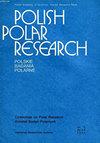斯匹次卑尔根岛南部的温泉和矿泉
IF 0.8
4区 地球科学
Q4 ECOLOGY
引用次数: 3
摘要
在斯匹次卑尔根南部地区,热水和矿泉水主要与次永久冻土层深层环流有关,与浅层环流和冰川水混合。对位于Stormbukta (Sørkappland)地区的4个温泉进行了研究和分析。在热水中,主要的阳离子是钠,而主要的阴离子是氯化物和碳酸氢盐。矿泉水和热水的温度范围为3.4至15.1°C。pH值在7.43 ~ 8.41之间。地热水的总溶解固形物(TDS)含量在346 ~ 4031 mg/l之间,其中Olsok温泉的TDS最高。根据其物理化学特征的变化,将研究区划分为两种热水类型。第一种类型与源自深层循环水的热水有关。第二种类型与源自亚冻土层热盐水与冰川水混合的热水和矿泉水有关。本文章由计算机程序翻译,如有差异,请以英文原文为准。
Thermal and mineral springs of southern Spitsbergen
: In the southern Spitsbergen area, thermal and mineral waters are primarily associated with subpermafrost deep circulation, being mixed with shallow circulation and glacial waters. Four thermal springs, located in the region of Stormbukta (Sørkappland), were studied and analyzed. In the thermal waters, the main cation is sodium, while the main anions are chloride and bicarbonate. The temperatures of the mineral and thermal waters range from 3.4 to 15.1°C. The pH values are between 7.43 and 8.41. The total dissolved solids (TDS) content of the geothermal waters is in the range of 346–4031 mg/l and the Olsok thermal spring has the highest TDS values. Based on the variation in physicochemical characteristics, two thermal water types were distinguished in the study area. The first type is associated with thermal waters originating from deep circulation waters. The second type is associated with the thermal and mineral waters originating from the mixture of subpermfrost hot brines with glacial waters.
求助全文
通过发布文献求助,成功后即可免费获取论文全文。
去求助
来源期刊

Polish Polar Research
ECOLOGY-GEOSCIENCES, MULTIDISCIPLINARY
CiteScore
2.00
自引率
7.70%
发文量
0
审稿时长
>12 weeks
期刊介绍:
The quarterly Polish Polar Research edited by the Committee on Polar Research of the Polish Academy of Sciences is an international journal publishing original research articles presenting the results of studies carried out in polar regions.
All papers are peer-reviewed and published in English.
The Editorial Advisory Board includes renowned scientist from Poland and from abroad.
 求助内容:
求助内容: 应助结果提醒方式:
应助结果提醒方式:


